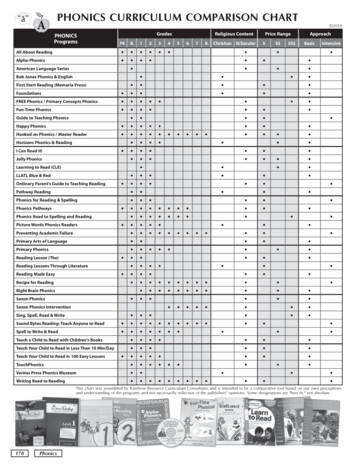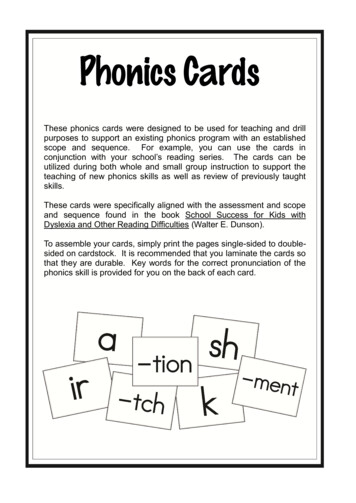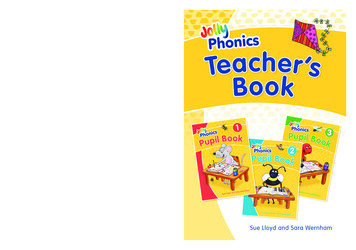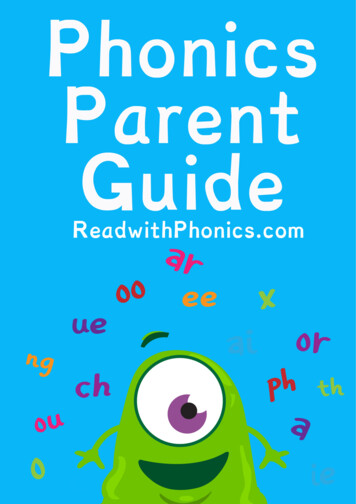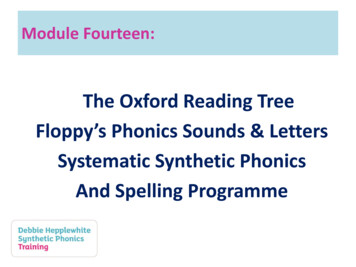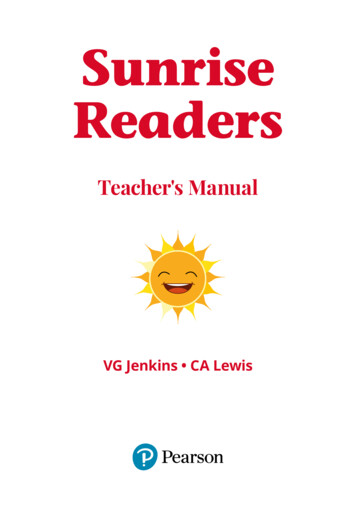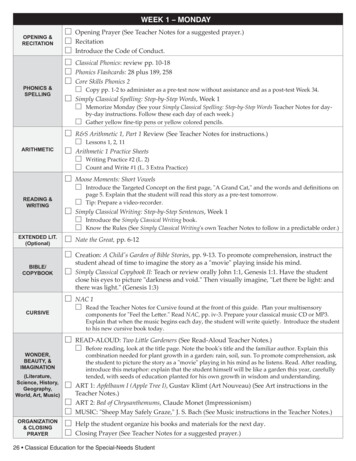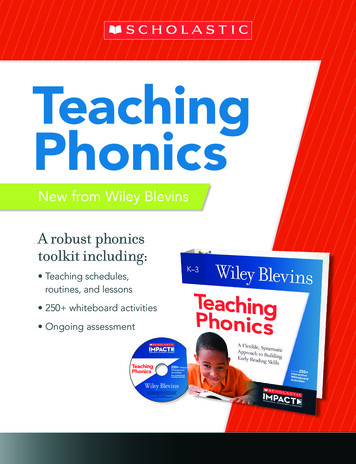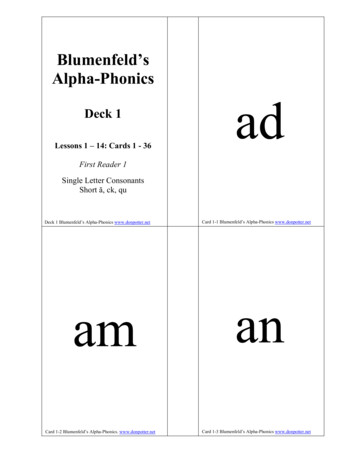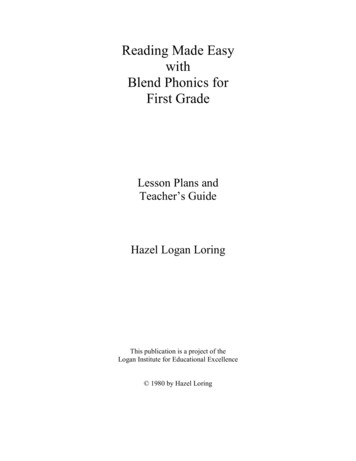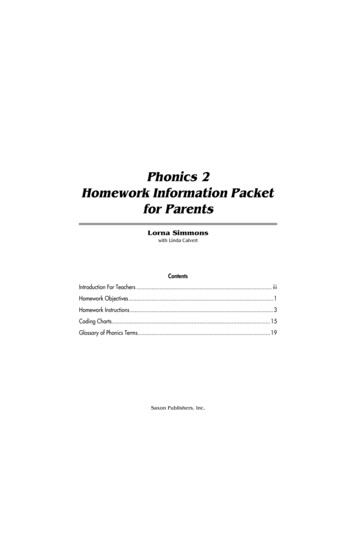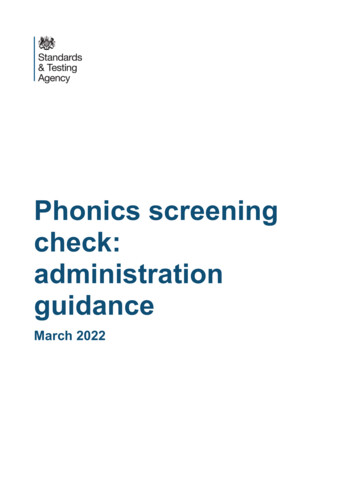
Transcription
Phonics screeningcheck:administrationguidanceMarch 2022
Contents1 Introduction32 Headteachers’ responsibilities43 Maladministration54 Participating pupils64.1 Pupils absent during check week64.2 Pupils who should not take the check65 Receiving and storing materials85.1 Braille versions85.2 How to check your delivery95.3 Security of check materials96 Preparing to administer the check106.1 Check administrators106.2 Preparing rooms106.3 Access arrangements107 Administering the check137.1 Assistance147.2 Problems or queries during the check147.3 Completing the answer sheet147.4 Scoring the check157.5 Administering the check at an alternative location158 After the check168.1 Headteacher’s declaration form169 Reporting check results179.1 Reporting to local authorities179.2 Pupils who move schools179.3 How results will be used189.4 Reporting results to parents189.5 Pupils who do not meet the expected standard1910 Further information2010.1 General enquiries2010.2 Message us202
1 IntroductionThis guidance is for schools administering the 2022 phonics screening check. Theinformation expands on section 8 of the 2022 key stage 1 (KS1) assessment andreporting arrangements 1 (ARA).It includes information to ensure schools can: prepare for check administrationprepare check administratorsadminister the check correctlyThe information is relevant to: school leaders, school staff and governing bodies in all maintained schools,academies, and free schoolsmaintained nursery schools that have eligible pupilsMinistry of Defence (MoD) schoolslocal authorities (LAs)Schools should administer the check during the week beginning Monday 6 June. Section3 of the 2022 KS1 ARA contains a list of important dates.Headteachers are responsible for the check administration arrangements within theirschool. Failing to adhere to this guidance could lead to a maladministrationinvestigation -investigating-allegations-of-maladministration3
2 Headteachers’ responsibilitiesHeadteachers must: identify which pupils should take the checkconsider whether any pupils will need braille versionsconsider whether any pupils will need modified versions and download them fromthe Primary Assessment Gateway 3 (excluding braille) during the check periodkeep check materials secure until Monday 20 Juneknow what to expect if they receive a monitoring visit 4ensure all check administrators are appropriately trainedensure that pupils are in a fit physical and mental state to take the checkensure the check is administered once to each eligible pupilensure pupils’ responses are scored accurately and consistentlyensure any pupils who do not meet the expected standard continue to receivesupport in phonicsreport any incident that affects the integrity, security or confidentiality of the checkto the Standards and Testing Agency (STA)follow the annual statutory data collection requirements by submitting checkresults to the LA 5 for all eligible pupils, by the deadline communicated to them bythe LAcomplete and submit the phonics screening check headteacher’s declaration form(HDF) by Friday 1 JulySchools not complying with these requirements may be subject to a maladministrationinvestigation tigating-allegations-of-maladministration344
3 MaladministrationThe term maladministration refers to any act that: affects the integrity, security or confidentiality of the national curriculumassessmentscould lead to results that do not reflect pupils’ unaided workYour school could be subject to a maladministration investigation 7 if it does not complywith the following: the 2022 KS1 ARAthis check administration guidancecheck administration instructions provided with the check materialsYou should consider taking steps to protect staff involved in administering the check.Misunderstandings about correct check administration can lead to allegations ofmaladministration. To avoid this, ensure all staff, participating pupils and their parentsunderstand: how the check will be administeredwhat assistance is and is not allowed in the checkConcerns about the administration of the check, or any allegations of maladministration(which could include cheating), should be reported to STA by contacting the nationalcurriculum assessments helpline on 0300 303 3013 or legations-of-maladministration5
4 Participating pupilsWith some exceptions (see section 4.2), all pupils who have reached the age of 6 by theend of the school year must take the check during that academic year. For the majority ofpupils, this will be in year 1. This includes pupils registered at maintained nursery schoolswho will reach the age of 6 before the end of the school year and have completed theyear 1 programme of study.Pupils who will have reached the age of 7 by the end of the academic year (the majorityof such pupils will be in year 2) who have not taken the test before, or who did not meetthe expected standard in the autumn check, must also take the test.For a new pupil joining the school and who will reach the age of 7 this academic year, theschool should confirm if the pupil should participate in the check. The common transferfile 8 (CTF) sent from the previous school should include information to confirm if the pupilmet the expected standard the previous year. If this information is not provided, youshould contact your LA or log into Get information about pupils via DfE Sign-in 9 to searchfor the pupil by their unique pupil number (UPN).If you cannot establish whether the pupil took the check in the autumn term, the pupilshould take the check.4.1 Pupils absent during check weekIf a pupil is absent during the check week, you can administer the check to them untilFriday 17 June. Any pupil who is absent from school for this entire period should berecorded as absent in the results data.4.2 Pupils who should not take the checkHeadteachers make the final decision about whether it is appropriate for a pupil to takethe check. In any instances when pupils are not entered for the check, schools shouldexplain their decision to the pupil’s parents. If appropriate, they should provide theparents with documentary evidence to support their decision. Where the decision hasbeen made not to administer the check to a pupil, schools should also explain how theyare helping the pupil learn to decode using v.uk6
If it is not appropriate for a pupil to take the check, it is important teachers are aware ofthat pupil’s progress in phonics so they can plan the next steps in their teaching.You may want to provide a similar experience for pupils who will not formally participatein the check. You could do this by modifying the practice sheet to include only singleletters or simple 2-letter blends so they can demonstrate their skills. Check materials,including the practice sheet, are available on the Primary Assessment Gateway fromMonday 6 June.Schools must submit data for all pupils including those who do not take the check. Pupilswho do not take the check should be marked as ‘D’ (headteacher decided it wasinappropriate for the pupil to take the check).Pupils working below the standardIf a pupil has not completed the first year of the KS1 English programme of study or hasshown no understanding of grapheme-phoneme correspondences, they should not takethe check.Pupils for whom English is an additional languageIf a pupil has limited fluency in English, you may decide they should not take the check. Ifa pupil has recently moved to the country and is unable to understand letters and soundsin English, they should not take the check.Pupils who use British Sign LanguageYou should consider whether pupils who use British Sign Language (BSL) or other signsupported communication, can be supported to take the check and demonstrate theirability in linking letters and sounds.Pupils who are mute or selectively mutePupils who are mute or selectively mute are unable to participate in the check if they donot give verbal responses aloud in school. They may be able to identify the words but willnot be able to demonstrate that knowledge by speaking the answers aloud.Selectively mute pupils may demonstrate their knowledge at home informally with afamily member who can discuss the outcome with the teacher. This arrangement willensure the pupil has had a similar experience to their peers and gives them anopportunity to demonstrate their skills.To avoid a potential security risk to the check materials, this arrangement may only takeplace after the check period ends on Friday 17 June.7
5 Receiving and storing materialsYou should ensure your school has adequate space to store materials securely. STA willdeliver materials to school addresses taken from Get Information About Schools 10 so youmust ensure your school details are up to date by logging in via DfE Sign-in 11.We will deliver check materials between Monday 16 May and Friday 20 May. If yourschool will be closed and you have not entered your holiday dates on the PrimaryAssessment Gateway, or contacted us to arrange an alternative delivery date, contactthe national curriculum assessments helpline on 0300 303 3013.Schools do not need to order standard versions of the phonics screening check.Materials are sent to schools based on school census data. You will receive one set ofmaterials per 30 pupils.Each set of materials will contain one: copy of ‘Phonics screening check: pupils’ materials’pad containing 30 copies of ‘Phonics screening check: answer sheet’copy of ‘Phonics screening check: practice sheet’copy of ‘2022 Phonics screening check: scoring guidance’You can download practice materials 12 to see what the check looks like.For additional materials, schools can download check materials from the PrimaryAssessment Gateway from Monday 6 June. This includes the mark sheet and modifiedversions (excluding braille), including Word versions with colour images, Word versionswith black and white images, and Word versions without images.If you have not received materials by Friday 20 May, if a delivery is incomplete, or ifcheck packs arrive unsealed or damaged, you should contact the national curriculumassessments helpline on 0300 303 3013. You may be asked to send a photograph of anydamaged packages.5.1 Braille versionsSchools can order uncontracted (Grade 1) Unified English Braille versions of the phonicsscreening check. Braille materials should be ordered from the national curriculumassessments helpline on 0300 303 3013 by Tuesday 26 April. Schools will receive essments-practice-materials10118
materials, including any braille orders, in the week beginning Monday 16 May. If schoolshave not received their check materials by Friday 20 May, they should contact thenational curriculum assessments helpline on 0300 303 3013.5.2 How to check your deliveryThe headteacher is responsible for checking their school’s delivery against the deliverynote to ensure the correct number of check materials have been received. If theheadteacher is unavailable, they must delegate this responsibility to a senior member ofstaff who understands the process.When you receive your materials, you should open the box and check the number ofpacks against the delivery note. STA recommends 2 members of school staff undertakethis check together. Leave the inner packs unopened and store your delivery securelyuntil Monday 6 June.5.3 Security of check materialsHeadteachers must ensure the integrity of the check is maintained so that no pupil hasan advantage. Schools must follow the guidance on keeping materials secure 13 and treatcheck materials as confidential from when they are received, or downloaded from thePrimary Assessment Gateway, until Monday 20 June.Check packs must not be opened before Monday 6 June. They must only be openedwhen the check is going to be administered for the first time.To maintain the confidentiality and integrity of the check, check administrators must notdiscuss the content with anyone or use the check words to prepare pupils. Specificcontent that could compromise a test must not be discussed on social media or publishedonline.Any school behaviour that leads to check materials being shared before Monday 20 Junecould lead to a maladministration investigation.If you suspect a breach of security, you should report the incident immediately to thenational curriculum assessments helpline on 0300 303 3013. STA will investigate theincident and take action, where ecurityadvice139
6 Preparing to administer the check6.1 Check administratorsA member of staff who is trained in phonics and known to the pupil must administer thecheck on a one-to-one basis. The role requires professional judgement about whichresponses are correct. The check should not be administered by a teaching assistant ora higher-level teaching assistant unless they are trained in phonics and have experiencedelivering phonics sessions to pupils. Adults administering the check must not be arelative, carer or guardian of the pupil taking the check.Check administrators should familiarise themselves with this guidance and with: guidance on how to keep check materials secure 14the printed instructions for administering the checkguidance on how to score pupils’ responses 15the check video and practice materials 166.2 Preparing roomsAdminister the check in a room that is quiet and provides a comfortable, well-lit space.Rooms should be prepared before pupils are admitted. Displays or materials which couldhelp pupils must be removed or covered for the duration of the check. If more than oneadult is administering the check to pupils at the same time, you may need more than oneroom to ensure pupils taking the check do not disturb, distract or aid one another.6.3 Access arrangementsYou may need to adapt the check for some pupils. Adjustments must be based onnormal classroom practice for pupils with specific needs. You do not need to requestpermission to make adaptations, but you must ensure any modifications do notadvantage or disadvantage pupils.Those who may need adjustments include le-materials-and-training-video10
for whom provision is being made in school under special educational needs anddisability (SEND) support and whose learning difficulty or disability significantlyaffects access to the checkwith an education, health and care (EHC) planwith a disability (as defined in section 6(1) of the Equality Act 2010 17) that does notgive rise to a special educational need but requires alternative accessarrangementswho are unable to sit and work for a sustained period because of a disability orbehavioural, emotional or social difficultyIt is not possible to list all the circumstances in which pupils may need adaptations. If youneed to discuss access arrangements to meet a pupil’s specific needs, you should usethe ‘Message us – access arrangements’ form on the Primary Assessment Gateway. Forgeneral enquiries you should contact the national curriculum assessments helpline.Rest breaksThe check is not timed but we expect it will take each pupil between 4 and 9 minutes tocomplete. You should give pupils enough time to respond to each word. If you believe apupil will find it difficult to concentrate, or may experience fatigue during the check, youmay use rest breaks to make it more manageable. Rest breaks can be given wheneverthey are needed.When planning for the check, consider when it would be most appropriate for the pupil totake a break. If the pupil is likely to need a rest break more frequently than between the 2sections of the check, or at the end of a page, we recommend you modify the materialsso there are fewer words on each page. The pupil must be kept separate from the rest ofthe cohort during a rest break. The check must be completed on the same day.Cued speechIf the pupil is familiar with cued speech, it can be used by a professional skilled in its useand by a pupil with a hearing impairment to make their responses clear. If a pupil with ahearing impairment would prefer to speak the words, then cued speech should be usedto help clarify what sounds they are aiming /611
Visual phonicsThese techniques can be used to help pupils make their responses clear if this is normalclassroom practice.Sound buttonsIf a pupil uses sound buttons to help them decode words as part of normal classroompractice, they may use them during the check. You must give the pupil a clean copy ofthe check so they can mark the sound buttons against the graphemes. You must notmark the graphemes for the pupil.ReadersReaders are not allowed.Adapting check materialsThe check materials are provided in font ‘Sassoon Infant’, style ‘regular’ and size ‘60’.Most pupils will use standard versions of the phonics screening check, but you may needto adapt check materials to meet pupils’ specific needs.Schools can download check materials from the Primary Assessment Gateway fromMonday 6 June. This includes: the mark sheet and modified versions (excluding braille)Word versions with colour imagesWord versions with black and white imagesWord versions without imagesThe materials are designed so schools can modify them to meet the needs of individualpupils and their own approach to teaching phonics. Examples of modifications mayinclude: changing the fontchanging the font sizehaving fewer words per pagecoloured overlays (if this is normal classroom practice)12
7 Administering the checkPupils must only attempt the check once during the check window. You should introducethe check as consistently as possible, bearing in mind some pupils may require moreexplanation to understand the instructions.The check materials include a double-sided practice sheet with 4 pseudo-words and 4real words on each side. You can use this to familiarise pupils with the check. If a pupil isstruggling to decode the words on the practice sheet, you should stop and discuss withyour headteacher whether that pupil should participate in the check.The following text provides an example of how you could introduce the check:“In this activity, I am going to ask you to read some words aloud.You may have seen some of the words before and others will be new to you.You should try to read each word but do not worry if you cannot. If it helps you,you may sound out the letters before trying to say the word.This practice sheet shows you what the words will look like.Have a go at reading these 4 words aloud, which you should have come acrossbefore [in, at, beg, sum].The words on this side [turn over practice sheet] are not real words. They arenames for types of imaginary creatures. You can see a picture of the creature nextto each word.Can you read out the words on this page for me? [ot, vap, osk, ect]Now you are going to start reading out the words in this booklet and I am going towrite down what you say on my sheet.In this booklet, there are 4 words on each page. I will tell you at the start of eachpage whether they are real words that you may have seen before or names fortypes of imaginary creatures.The first page has names for types of imaginary creatures, and you can see theirpictures.Can you start reading the words to me?”It is important to tell the pupil whether they are real words or types of imaginary creatureson each page.13
7.1 AssistanceYou must ensure nothing you say, or do, during the check could be interpreted as givingpupils an advantage.If a pupil is likely to be confused by the standard introduction, you may develop your own.Your instructions may refer to the practice words but must not refer to words within thecheck itself.You can point to whole words to indicate which word comes next, but you must be carefulnot to point to the words in a way that indicates how to decode them. For example, avoidpointing from left to right or hovering over letters.During the practice, you can give further guidance to ensure pupils understand the task.For example, you may remind the pupil the word must be blended, guidance which wouldnot be allowed during the check itself.Pupils should be given as long as necessary to respond to a word, although in mostcases 10 seconds should be enough. You should not indicate whether a pupil hasdecoded a word correctly, or incorrectly, during the check, but you may offerencouragement. You should decide when it is appropriate to tell the pupil to move ontothe next word, taking care not to do so while they are still trying to decode the word.7.2 Problems or queries during the checkMost pupils should be able to attempt all words in the check. However, it is importantthey do not become distressed or have a negative experience. If a pupil is struggling, youshould consider stopping the check before the end.Similarly, if a pupil is showing signs of fatigue, you should consider using a rest break. Ifa pupil needs frequent, lengthy rest breaks, think about stopping the check completely.When making the decision to stop, ensure the pupil has been given a full opportunity toshow what they can do. If the check is stopped before the end, you should report thepupil’s score for what they have attempted.7.3 Completing the answer sheetYou should use the answer sheets to record each pupil’s responses during the check, soyou have an accurate record of how many words a pupil read correctly.You can also use them to record your own comments, for example any graphemes apupil did not recognise or when blending was difficult. This may help you plan futurephonics teaching.If you are not familiar with the answer sheets, past materials are available on GOV.UK.14
7.4 Scoring the checkInstructions for scoring the check will be included with the check materials. You shouldscore the check as the pupil says each word. Make a record on the answer sheet ofwhether the pupil said each word correctly or not. You should consider the followingpoints when scoring the check: if a pupil sounds out the phonemes but does not blend the word, they must not beprompted to do so, and this must be scored as incorrectpupils may elongate phonemes but if they leave gaps between phonemes and donot blend them, this must be scored as incorrectalternative pronunciations must be considered when deciding whether a responseis correct—for real words, inappropriate grapheme-phoneme correspondencesmust be marked as incorrect (for example, reading ‘blow’ to rhyme with ‘cow’would be incorrect)alternative pronunciations of graphemes will be allowed in pseudo-words—thescoring guidance gives some alternative pronunciations, but the list of acceptablepronunciations is not exhaustivea pupil’s accent should be considered when deciding whether a response isacceptable and there must be no bias for or against a pupil with a particularaccent—pupils can use any acceptable regional pronunciation even if it is notwithin their usual accentany pronunciation difficulties should be considered when deciding whether aresponse is acceptable—for example, a pupil unable to form the ‘th’ sound whoinstead usually says ‘f’ should have this scored as correctif a pupil shows their ability to decode by revising an attempt, this should bemarked as correct—however, pupils must not be prompted to ‘have another go’and the final attempt must be scored, even if this is incorrect and a previousattempt was correct7.5 Administering the check at an alternative locationSchools can administer the check at an alternative location to the rest of the cohort awayfrom school. This may include administering at a pupil referral unit or at the pupil’s home,as long as the pupil is in a fit state.The headteacher is responsible for ensuring the security and confidentiality of the checkis maintained, and the check is administered according to this check administrationguidance.If schools need specific advice on administering the check at an alternative location, theyshould contact STA using the ‘Message us – access arrangements’ form on the PrimaryAssessment Gateway.15
8 After the check8.1 Headteacher’s declaration formHeadteachers must complete and submit the HDF after your school has completed thecheck, as detailed in article 5A(1)(c) of the Education (National Curriculum) (Key Stage 1Assessment Arrangements) (England) Order 2004 18. You must still complete the HDF ifall pupils are working below the standard of the check.The HDF confirms either: your school has administered the check according to the published guidancethe check was not administered because all pupils are working below the standardor are unable to access itthe statements in the HDF cannot be confirmed and you have reported any issuesto STAYou, or a delegated senior member of staff, must complete and submit the HDF onlineafter the last check has been administered. The HDF will be available on the PrimaryAssessment Gateway from Monday 6 June and must be submitted by Friday 1 July.Failure to complete the HDF by the deadline may result in a maladministrationinvestigation. If you, or a delegated senior member of staff, cannot complete the HDF orneed help completing it, contact the national curriculum assessments helpline. Youcannot amend the HDF after /contents/made16
9 Reporting check resultsSTA will publish the threshold mark on Monday 20 June on GOV.UK. Schools do notneed to wait until the threshold mark is published before submitting their data to the LA.9.1 Reporting to local authoritiesSchools must report their pupils’ check scores to the LA by their submission deadline.Results must be submitted for all pupils who are eligible to take the check, using thefollowing codes:DescriptionWhat to recordPupil took the check and met theexpected standardScore – record in the phonics mark fieldPupil took the check and did notmeet the expected standardScore – record in the phonics mark fieldAbsentA – record in the phonics outcome fieldHeadteacher decided it was notappropriate for pupil to take thecheckD – record in the phonics outcome fieldPupil left the schoolL – record in the phonics outcome fieldCheck subject to maladministrationQ – record in the phonics outcome fieldThe LA will tell you how to submit your data and by when. Management informationsystem (MIS) suppliers have been advised of the data requirements for the check. YourLA or MIS supplier, depending on local arrangements, may offer support for thesesystems.LAs must submit check data to the Department for Education (DfE) using COLLECT byFriday 22 July. There is no facility to amend data once the collection has closed. Furthersupport for schools and LAs is available in DfE’s data collection and submissionguidance 19.9.2 Pupils who move schoolsIf a pupil moves ck-data-collection17
before the check administration period—the receiving school should assess thepupil and submit data for themduring the check period—the receiving school should find out whether the pupilhas already taken the check (if not, they should assess the pupil and submit datafor them)after taking the check—their result should be submitted by the school where theytook the check and provided to the new school in the CTFIf a pupil arrives from a non-participating school, for example they have recently arrivedfrom overseas or were electively home educated, the receiving school should consideradministering the check and must submit data for them. Pupils who arrive after the checkadministration period, and who did not take the check, do not need to be included in thatyear’s data submission.9.3 How results will be usedDfE does not publish school-level results for the phonics screening check.Results will be available in Analyse School Performance 20 and schools will also haveaccess to national and LA results 21 to allow them to benchmark their pupils’ performance.9.4 Reporting results to parentsHeadteachers must report the pupils’ scores to parents by the end of the summer term.This should include whether or not their child has met the expected standard to ensurethey are aware of their child’s progress in developing phonics decoding skills. If a pupilhas not met the expected standard, headteachers should outline the support that will beput in place to help the pupil progress.For year 2 pupils who take the check in autumn 2021 and June 2022, schools mustreport both results to parents. Headteachers can choose how to communicate results toparents, which should be provided in the context of their overall attainment and progress.Headteachers must provide reports for all pupils, including those who have left the schoolor were absent during the gov.uk/find-statistics18
9.5 Pupils who do not meet the expected standardThe DfE has published guidance 22 on what schools should do if a pupil does not meetthe expected standard.Pupils who have not met the expected standard
keep check materials secure until Monday 20 June know what to expect if they receive a monitoring visit. 4 ensure all check administrators are appropriately trained ensure that pupils are in a fit physical and mental state to take the check ensure the check is administered once to each eligible pupil
